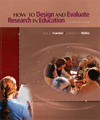Jack R. Fraenkel,
San Francisco State University
Norman E. Wallen,
San Francisco State University
| Analysis of covariance (ANCOVA) | A statistical technique for equating groups on one or more variables when testing for statistical significance; it adjust scores on a dependent variable for initial differences on other variables, such as pretest performance or IQ.
|
 |
 |
 |
| Analysis of variance (ANOVA) | A statistical technique for determining the statistical significance of differences among means; it can be used with two or more groups.
|
 |
 |
 |
| Chi-square test | A non parametric test of statistical significance appropriate when the data are in the form of frequency counts; it compares frequencies actually observed in a study with expected frequencies to see if they are significantly different.
|
 |
 |
 |
| Confidence interval | An interval used to estimate a parameter that is constructed in such a way that the interval has a predetermined probability of including the parameter.
|
 |
 |
 |
| Degrees of freedom | A number indicating how many instances out of a given number of instance are "free to vary" – that is, not predetermined.
|
 |
 |
 |
| Friedman two-way analysis of variance | A nonparametric inferential statistic used to compare two or more groups that are not independent.
|
 |
 |
 |
| Inferential statistics | Data analysis techniques for determining how likely it is that results based on a sample or samples are similar to results that would have been obtained for the entire population.
|
 |
 |
 |
| Kruska-Wallis one-way analysis of variance | A nonparametric inferential statistic used to compare two or more independent groups for statistical significance of differences.
|
 |
 |
 |
| Level of significance | The probability associated with a confidence interval; the probability that the interval will contain the corresponding parameter. Commonly used confidence levels in educational research are the 95 and 99 percent confidence levels.
|
 |
 |
 |
| Mann-Whitney U test | A nonparametric inferential statistic used to determine whether two uncorrelated groups differ significantly.
|
 |
 |
 |
| Multivariate analysis of covariance (MANCOVA) | An extension of analysis of covariance that incorporates two or more dependent variables in the same analysis.
|
 |
 |
 |
| Multivariate analysis of variance (MANOVA) |
|
 |
 |
 |
| Nonparametric technique | A test of statistical significance appropriate when the data represent an ordinal or nominal scale, or when assumptions required for parametric tests cannot be met.
|
 |
 |
 |
| Null hypothesis | A statement that any difference between obtained sample statistics and specified population parameters is due to sampling error, or "chance."
|
 |
 |
 |
| One-tailed test | The use of only one tail of the sampling distribution of statistic – used when a directional hypothesis is stated.
|
 |
 |
 |
| Parametric technique | A test of significance appropriate when the data represent an interval or ratio scale of measurement and other specific assumptions have been met.
|
 |
 |
 |
| Power of a statistical test | The probability that the null hypothesis will be rejected when there is a difference in the populations; the ability of a test to avoid a Type II error.
|
 |
 |
 |
| Practical significance | A difference large enough to have some practical effect. Contrast with statistical significance, which may be so small as to have no practical consequences.
|
 |
 |
 |
| Probability | The relative frequency with which a particular event occurs among all events of interest.
|
 |
 |
 |
| Research hypothesis | A prediction of study outcomes. Often a statement of the expected relationship between two or more variables.
|
 |
 |
 |
| Sampling distribution | The theoretical distribution of all possible values of a statistic from all possible samples of a given size selected from a population.
|
 |
 |
 |
| Sampling error | Expected, chance variation in sample statistics that occurs when successive samples are selected for the sample in systematic sampling.
|
 |
 |
 |
| Sign test | A nonparametric inferential statistic used to compare two groups that are not independent.
|
 |
 |
 |
| Standard error of the mean | The standard deviation of sample means that indicates by how much the sample means can be expected to differ if other samples from the same population are used.
|
 |
 |
 |
| Statistically significant | The conclusion that results are unlikely to have occurred due to sampling error or "chance;" an observed correlation or difference probably exists in the population.
|
 |
 |
 |
| t-test for means | A parametric technique for comparing two means.
|
 |
 |
 |
| t-test for r | A parametric technique for determining if there is a non-zero correlation among two variables in the population.
|
 |
 |
 |
| Two-tailed test | Use of both tails of the sampling distribution of a statistic – when a nondirectional hypothesis is stated.
|
 |
 |
 |
| Type I error | The rejection by the researcher of a null hypothesis that is actually true. Also called alpha error.
|
 |
 |
 |
| Type II error | The failure of a researcher to reject a null hypothesis that is really false. Also called beta error.
|
 |
 |
 |
| Wilk's lambda | The numerical index calculated when carrying out MANOVA or MANCOVA.
|



 2003 McGraw-Hill Higher Education
2003 McGraw-Hill Higher Education